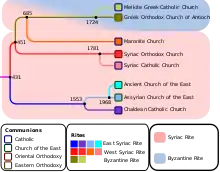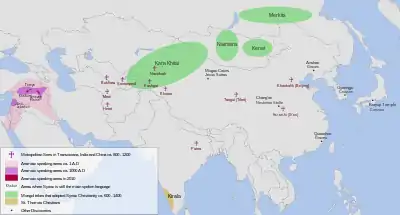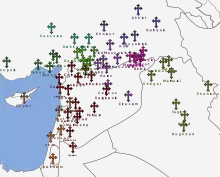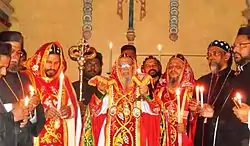Сирийское христианство
Сирийское христианство (сир. ܡܫܝܚܝܘܬܐ ܣܘܪܝܝܬܐ / Mšioyuṯo Suryoyto или Mšiḥāyūṯā Surāyṯā) представляет собой особенную ветвь восточного христианства, чьи основные богословские сочинения и традиционные литургии написаны на классическом сирийском языке, разновидности арамейского языка[1][2][3]. В более широком смысле этот термин может также относиться к арамейскому христианству в целом, охватывая, таким образом, все христианские традиции, основанные на литургическом использовании арамейского языка и его вариаций, как исторических, так и современных[4][5][6].





Наряду с греческим и латинским, классический сирийский был одним из трёх наиболее важных языков раннего христианства[7]. На нём развилась особая сирийская формы христианства, которая процветала на Ближнем Востоке и в других частях Азии в период поздней античности и раннего средневековья, дав начало различным литургическим и деноминационным традициям, представленным в современном мире несколькими церквями, которые продолжают религиозное и культурное наследие сирийского христианства[8] [9].
Сирийское христианство включает в себя две литургические традиции.[10] Восточно-сирийский обряд (также известный как халдейский, ассирийский, сасанидский, вавилонский или персидский обряд)[11], основной анафорой которого является Священная Курбана Святых Фаддея и Мария. Его используют иракская Халдейская католическая Церковь, Ассирийская церковь Востока и Древняя Ассирийская церковь Востока, а также Индийская Сиро-малабарская католическая церковь и Халдейская сирийская церковь (последняя является частью Ассирийской церкви Востока).
Западно-сирийский обряд (также называемый антиохийским сирийским обрядом или обрядом Святого Иакова), анафора которого имеет Божественную литургию святого Иакова. Его использует Сирийская православная церковь, Ливанской маронитская церковь и сирийская католическая церковь, а также Индийская Сиро-Маланкарская католическая церковь, Маланкарская православная сирийская церковь, Сирийская христианская церковь якобитов (часть Сирийской православной церкви), Малабарская независимая сирийская церковь. Модифицированная версия этого обряда используется сирийской церковью Маланкара Мар Тома[12][13][14] и более реформатской евангелической церковью Св. Фомы Индии.
В Индии восточных христиан (христиан апостола Фомы) обеих литургических традиций (восточной и западной) называют «сирийскими» христианами. Традиционная восточно-сирийская община представлена Сиро-Малабарской церковью и Халдейской сирийской церковью Индии (часть Ассирийской церкви Востока). Западно-сирийская литургическая традиция была введена после 1665 года, и связанная с ней община представлена якобитской сирийской христианской церковью (часть Сирийской православной церкви), Маланкарской православной сирийской церковью (обе принадлежат к древневосточному православию), Католическая церковь Сиро-Маланкара (восточно-католическая церковь), Сирийская церковь Маланкара Мартома (часть Англиканской общины) и Малабарская независимая сирийская церковь (независимая православная церковь, не являющаяся частью Вселенской православной Церкви). [15]
Сирийский язык — разновидность арамейского языка, возникшая в Эдессе, Верхней Месопотамии, в первые века нашей эры[16]. Тесно связанный с арамейским языком Иисуса, галилейским диалектом. Эта связь добавила ему престижа в христианской среде[17]. Форма языка, используемая в Эдессе, преобладала в христианских писаниях и была принята как стандартная форма, «удобное средство распространения христианства везде, где есть субстрат разговорного арамейского»[1]. Район, где говорили на сирийском или арамейском языке, зона соприкосновения и конфликта между Римской империей и Сасанидской империей, простирался от Антиохии на западе до Селевкии-Ктесифона, столицы Сасанидов (в Ираке), на востоке и включал всю или части современной Сирии, Ливана, Израиля/Палестины, Ирака и части Турции и Ирана[2][1].
Церкви сирийской традиции
- Древневосточные православные церкви
- Сиро-яковитская православная церковь (нехалкидонская древневосточная православная церковь Антиохии и всего Востока)
- Маланкарская яковитская сирийская ортодоксальная церковь (нехалкидонская древневосточная православная церковь Индии в составе Сирийского Патриархата)
- Маланкарская православная церковь (автокефальная; нехалкидонская древневосточная православная церковь Индии) к ней также относится Гоанская православная церковь
- Сиро-яковитская православная церковь (нехалкидонская древневосточная православная церковь Антиохии и всего Востока)
- Восточнокатолические церкви
- Маронитская католическая церковь,
- Сирийская католическая церковь,
- Сиро-маланкарская католическая церковь (сирийская католическая церковь в индийском штате Керала),
- Церковь Мар Тома, состоящая в евхаристическом общении с Англиканским сообществом
- Евангелическая церковь Индии святого Фомы, относится к Евангельским христианам;
- Независимые части Церкви Востока
- Восточно-сирийские церкви в составе Католической церкви
Восточно-сирийские христиане участвовали в миссии в Индии, и многие из нынешних церквей в Индии находятся в общении с сирийскими церквями. Эти индийские христиане известны как Христиане апостола Фомы.
Примечания
- Rompay, 2008, pp. 365–386.
- Murre van den Berg, 2007, p. 249.
- Kitchen, 2012, pp. 66–77.
- Simmons, 1959, p. 13.
- Aufrecht, 2001, p. 149.
- Quispel, 2008, p. 80.
- Brock, 2005, pp. 5–20.
- Winkler, 2019, pp. 119–133.
- Hunter, 2019, pp. 783–796.
- Varghese, 2019, pp. 391–404.
- John Hardon. Catholic Dictionary: An Abridged and Updated Edition of Modern Catholic Dictionary. — Crown Publishing Group, 25 June 2013. — P. 493. — ISBN 978-0-307-88635-4.
- Pallikunnil, Jameson K. The Eucharistic Liturgy: A Liturgical Foundation for Mission in the Malankara Mar Thoma Syrian Church. — 2017. — «Metropolitan Juhanon Mar Thoma called it “a Protestant Church in an oriental garb”. As a reformed Oriental Church, it agrees with the reformed doctrines of the Western churches. Therefore, there is much in common in faith and doctrine between the MTC and the reformed Churches of the West. As the Church now sees it, just as the Anglican church is a Western Reformed Church, the MTC is an Eastern Reformed Church..». — ISBN 978-1-5246-7652-0.
- World Council of Churches, «Mar Thoma Syrian Church of Malabar»
- Ed Hindson, Dan Mitchell (editors), The Popular Encyclopedia of Church History (Harvest House Publishers, 2013), p. 225
- Perczel, 2019, pp. 653–697.
- Brock, 1998, p. 708—719.
- Montgomery, 2002, p. 27.
Источники
- Abouzayd, Shafiq. The Maronite Church // The Syriac World. — London : Routledge, 2019. — P. 731–750. — ISBN 9781138899018.
- Andrade, Nathanael J. Syriac and Syrians in the Later Roman Empire: Questions of Identity // The Syriac World. — London : Routledge, 2019. — P. 157–174. — ISBN 9781138899018.
- Aufrecht, Walter E. A Legacy of Syria: The Aramaic Language (англ.) // Bulletin of the Canadian Society for Mesopotamian Studies. — 2001. — Vol. 36. — P. 145–155.
- Bar-Asher Siegal, Michal. Judaism and Syriac Christianity // The Syriac World. — London : Routledge, 2019. — P. 146–156.
- Baum, Wilhelm. The Church of the East: A Concise History / Wilhelm Baum, Dietmar W. Winkler. — London-New York : Routledge-Curzon, 2003. — ISBN 9781134430192.
- Baumer, Christoph. The Church of the East: An Illustrated History of Assyrian Christianity. — London-New York : Tauris, 2006. — ISBN 9781845111151.
- Brock, Sebastian P. (1982). “Christians in the Sasanian Empire: A Case of Divided Loyalties”. Studies in Church History. 18: 1—19. DOI:10.1017/S0424208400016004. ISBN 9780631180609.
- Brock, Sebastian P. Studies in Syriac Christianity: History, Literature, and Theology. — Aldershot : Variorum, 1992. — ISBN 9780860783053.
- Brock, Sebastian P. Eusebius and Syriac Christianity // Eusebius, Christianity, and Judaism. — Detroit : Wayne State University Press, 1992. — P. 212–234. — ISBN 0814323618.
- Brock, Sebastian P. A Brief Outline of Syriac Literature. — Kottayam : St. Ephrem Ecumenical Research Institute, 1997.
- Brock, Sebastian P. Syriac Culture, 337-425 // The Cambridge Ancient History. — Cambridge : Cambridge University Press, 1998. — Vol. 13. — P. 708–719. — ISBN 9780521302005.
- Brock, Sebastian P. From Ephrem to Romanos: Interactions Between Syriac and Greek in Late Antiquity. — Aldershot : Ashgate, 1999a. — ISBN 9780860788003.
- Brock, Sebastian P. (1999b). “St. Ephrem in the Eyes of Later Syriac Liturgical Tradition” (PDF). Hugoye: Journal of Syriac Studies. 2 (1): 5—25. DOI:10.31826/hug-2010-020103.
- Brock, Sebastian P. Eusebius and Syriac Christianity // Doctrinal Diversity: Varieties of Early Christianity. — New York and London : Garland Publishing, 1999c. — P. 258–280. — ISBN 9780815330714.
- Brock, Sebastian P. The Christology of the Church of the East in the Synods of the Fifth to Early Seventh Centuries: Preliminary Considerations and Materials // Doctrinal Diversity: Varieties of Early Christianity. — New York and London : Garland Publishing, 1999d. — P. 281–298. — ISBN 9780815330714.
- Brock, Sebastian P. (1999e). “The Importance of the Syriac Traditions in Ecumenical Dialogue on Christology”. Christian Orient. 20: 189—197.
- Brock, Sebastian P. Ephrem and the Syriac Tradition // The Cambridge History of Early Christian Literature. — Cambridge : Cambridge University Press, 2004a. — P. 362–372. — ISBN 9780521460835.
- Brock, Sebastian P. The Syriac Churches in Ecumenical Dialogue on Christology // Eastern Christianity: Studies in Modern History, Religion and Politics. — London : Melisende, 2004b. — P. 44–65. — ISBN 9781901764239.
- Brock, Sebastian P. The Syriac Orient: A Third 'Lung' for the Church? // Orientalia Christiana Periodica. — 2005. — Т. 71. — С. 5–20.
- Brock, Sebastian P. Fire from Heaven: Studies in Syriac Theology and Liturgy. — Aldershot : Ashgate, 2006. — ISBN 9780754659082.
- Brown, Leslie W. The Indian Christians of St Thomas: An Account of the Ancient Syrian Church of Malabar. — Cambridge : Cambridge University Press, 1956.
- Burnett, Stephen G. Christian Aramaism: The Birth and Growth of Aramaic Scholarship in the Sixteenth Century // Seeking Out the Wisdom of the Ancients. — Winona Lake : Eisenbrauns, 2005. — P. 421–436.
- Chabot, Jean-Baptiste. Synodicon orientale ou recueil de synodes nestoriens. — Paris : Imprimerie Nationale, 1902.
- Chaillot, Christine. The Syrian Orthodox Church of Antioch and All the East: A Brief Introduction to Its Life and Spirituality. — Geneva : Inter-Orthodox dialogue, 1998.
- Daryaee, Touraj. The Sasanian Empire // The Syriac World. — London : Routledge, 2019. — P. 33–43. — ISBN 9781138899018.
- Debié, Muriel (2009). “Syriac Historiography and Identity Formation”. Church History and Religious Culture. 89 (1—3): 93—114. DOI:10.1163/187124109X408014.
- Dickens, Mark. Syriac Christianity in Central Asia // The Syriac World. — London : Routledge, 2019. — P. 583–624. — ISBN 9781138899018.
- Donabed, Sargon G.; Mako, Shamiran (2009). “Ethno-cultural and Religious Identity of Syrian Orthodox Christians” (PDF). Chronos: Revue d'Histoire de l'Université de Balamand. 19: 69—111.
- Donabed, Sargon G. Reforging a Forgotten History: Iraq and the Assyrians in the Twentieth Century. — Edinburgh : Edinburgh University Press, 2015. — ISBN 9780748686056.
- Fiey, Jean Maurice. Communautés syriaques en Iran et Irak des origines à 1552. — London : Variorum Reprints, 1979. — ISBN 9780860780519.
- Griffith, Sidney H. Ephraem, the Deacon of Edessa, and the Church of the Empire // Diakonia: Studies in Honor of Robert T. Meyer. — Washington : CUA Press, 1986. — P. 25–52. — ISBN 9780813205960.
- Griffith, Sidney H. (2002). “Christianity in Edessa and the Syriac-Speaking World: Mani, Bar Daysan, and Ephraem, the Struggle for Allegiance on the Aramean Frontier”. Journal of the Canadian Society for Syriac Studies. 2: 5—20. DOI:10.31826/jcsss-2009-020104.
- Grillmeier, Aloys. Christ in Christian Tradition: The Churches of Jerusalem and Antioch from 451 to 600 / Aloys Grillmeier, Theresia Hainthaler. — Oxford : Oxford University Press, 2013. — Vol. 2/3. — ISBN 9780199212880.
- Haar Romeny, Bas ter. Ethnicity, Ethnogenesis and the Identity of Syriac Orthodox Christians // Visions of Community in the Post-Roman World: The West, Byzantium and the Islamic World, 300-1100. — Farnham : Ashgate Publishing, 2012. — P. 183–204. — ISBN 9781317001362.
- Hainthaler, Theresia. Theological Doctrines and Debates within Syriac Christianity // The Syriac World. — London : Routledge, 2019. — P. 377–390. — ISBN 9781138899018.
- Harvey, Susan A. Women and Children in Syriac Christianity: Sounding Voices // The Syriac World. — London : Routledge, 2019. — P. 554–566. — ISBN 9781138899018.
- Healey, John F. Aramaean Heritage // The Aramaeans in Ancient Syria. — Leiden : Brill, 2014. — P. 391–402. — ISBN 9789004229433.
- Healey, John F. Arameans and Aramaic in Transition – Western Influences and the Roots of Aramean Christianity // Research on Israel and Aram: Autonomy, Independence and Related Issues. — Tübingen : Mohr Siebeck, 2019a. — P. 433–446. — ISBN 9783161577192.
- Healey, John F. The Pre-Christian Religions of the Syriac-Speaking Regions // The Syriac World. — London : Routledge, 2019b. — P. 47–67. — ISBN 9781138899018.
- Herman, Geoffrey. The Syriac World in the Persian Empire // The Syriac World. — London : Routledge, 2019. — P. 134–145.
- Hovorun, Cyril. Will, Action and Freedom: Christological Controversies in the Seventh Century. — Leiden-Boston : Brill, 2008. — ISBN 9781138899018.
- Hunter, Erica C. D. Changing Demography: Christians in Iraq since 1991 // The Syriac World. — London : Routledge, 2019. — P. 783–796. — ISBN 9781138899018.
- Jakob, Joachim. Ostsyrische Christen und Kurden im Osmanischen Reich des 19. und frühen 20. Jahrhunderts. — Münster : LIT Verlag, 2014. — ISBN 9783643506160.
- Jobling, William J. (1996). “New Evidence for the History of Indigenous Aramaic Christianity in Southern Jordan”. Sydney Studies in Society and Culture. 12: 62—73.
- Jullien, Florence. Forms of the Religious Life and Syriac Monasticism // The Syriac World. — London : Routledge, 2019. — P. 88–104. — ISBN 9781138899018.
- Karim, Cyril Aphrem. Symbols of the Cross in the Writings of the Early Syriac Fathers. — Piscataway : Gorgias Press, 2004. — ISBN 9781593332303.
- Kitchen, Robert A. The Syriac Tradition // The Orthodox Christian World. — London-New York : Routledge, 2012. — P. 66–77. — ISBN 9781136314841.
- Khoury, Widad. Churches in Syriac Space: Architectural and Liturgical Context and Development // The Syriac World. — London : Routledge, 2019. — P. 476–553. — ISBN 9781138899018.
- Loopstra, Jonathan A. The Syriac Bible and its Interpretation // The Syriac World. — London : Routledge, 2019. — P. 293–308. — ISBN 9781138899018.
- Loosley, Emma. Peter, Paul and James of Jerusalem: The Doctrinal and Political Evolution of the Eastern and Oriental Churches // Eastern Christianity in the Modern Middle East. — London-New York : Routledge, 2010. — P. 1–12. — ISBN 9781135193713.
- Loosley, Emma. The Material Culture of the Syrian Peoples in Late Antiquity and the Evidence for Syrian Wall Paintings // The Syriac World. — London : Routledge, 2019. — P. 460–475. — ISBN 9781138899018.
- Menze, Volker L. The Establishment of the Syriac Churches // The Syriac World. — London : Routledge, 2019. — P. 105–118. — ISBN 9781138899018.
- Meyendorff, John. Imperial unity and Christian divisions: The Church 450–680 A.D.. — Crestwood, NY : St. Vladimir's Seminary Press, 1989. — ISBN 9780881410563.
- Millar, Fergus. A Greek Roman Empire: Power and Belief under Theodosius II (408–450). — Berkeley : University of California Press, 2006. — ISBN 9780520253919.
- Millar, Fergus (2013). “The Evolution of the Syrian Orthodox Church in the Pre-Islamic Period: From Greek to Syriac?” (PDF). Journal of Early Christian Studies. 21 (1): 43—92. DOI:10.1353/earl.2013.0002.
- Mingana, Alphonse (1926). “The Early Spread of Christianity in India” (PDF). Bulletin of the John Rylands Library. 10 (2): 435—514. DOI:10.7227/BJRL.10.2.7.
- Montgomery, Robert L. The Lopsided Spread of Christianity: Toward an Understanding of the Diffusion of Religions. — Westport : Praeger Publishers, 2002. — ISBN 9780275973612.
- Murre van den Berg, Heleen. Syriac Christianity // The Blackwell Companion to Eastern Christianity. — Malden : Blackwell, 2007. — P. 249–268. — ISBN 9780470766392.
- Murre van den Berg, Heleen. Classical Syriac, Neo-Aramaic, and Arabic in the Church of the East and the Chaldean Church between 1500 and 1800 // Aramaic in Its Historical and Linguistic Setting. — Wiesbaden : Harrassowitz Verlag, 2008. — P. 335–352. — ISBN 9783447057875.
- Murre van den Berg, Heleen. Classical Syriac and the Syriac Churches: A Twentieth-Century History // Syriac Encounters: Papers from the Sixth North American Syriac Symposium. — Louvain : Peeters Publishers, 2015. — P. 119–148. — ISBN 9789042930469.
- Murre-van den Berg, Heleen. Syriac Identity in the Modern Era // The Syriac World. — London : Routledge, 2019. — P. 770–782. — ISBN 9781138899018.
- Nichols, Aidan. Rome and the Eastern Churches: A Study in Schism. — 2nd revised. — San Francisco : Ignatius Press, 2010. — ISBN 9781586172824.
- O’Mahony, Anthony. Syriac Christianity in the modern Middle East // The Cambridge History of Christianity: Eastern Christianity. — Cambridge : Cambridge University Press, 2006. — Vol. 5. — P. 511–536. — ISBN 9780521811132.
- Penn, Michael Philip. Early Syriac Reactions to the Rise of Islam // The Syriac World. — London : Routledge, 2019. — P. 175–188. — ISBN 9781138899018.
- Perczel, István. Syriac Christianity in India // The Syriac World. — London : Routledge, 2019. — P. 653–697. — ISBN 9781138899018.
- Possekel, Ute. The Emergence of Syriac Literature to AD 400 // The Syriac World. — London : Routledge, 2019. — P. 309–326. — ISBN 9781138899018.
- Quispel, Gilles. Gnostica, Judaica, Catholica: Collected Essays of Gilles Quispel. — Leiden-Boston : Brill, 2008. — ISBN 9789047441823.
- Robinson, Theodore H. Robinson's Paradigms and Exercises in Syriac Grammar / Theodore H. Robinson, James F. Coakley. — 6th revised. — Oxford : Oxford University Press, 2013. — ISBN 9780199687176.
- Rompay, Lucas van. The East: Syria and Mesopotamia // The Oxford Handbook of Early Christian Studies. — Oxford : Oxford University Press, 2008. — P. 365–386. — ISBN 9780199271566.
- Ross, Steven K. Roman Edessa: Politics and Culture on the Eastern Fringes of the Roman Empire, 114-242 CE. — London-New York : Routledge, 2001. — ISBN 9781134660636.
- Saint-Laurent, Jeanne-Nicole. Syriac Hagiographic Literature // The Syriac World. — London : Routledge, 2019. — P. 339–354. — ISBN 9781138899018.
- Seleznyov, Nikolai N. (2008). “The Church of the East & Its Theology: History of Studies”. Orientalia Christiana Periodica. 74 (1): 115—131.
- Seleznyov, Nikolai N. (2010). “Nestorius of Constantinople: Condemnation, Suppression, Veneration: With special reference to the role of his name in East-Syriac Christianity”. Journal of Eastern Christian Studies. 62 (3—4): 165—190.
- Seleznyov, Nikolai N. (2013). “Jacobs and Jacobites: The Syrian Origins of the Name and its Egyptian Arabic Interpretations”. Scrinium: Journal of Patrology, Critical Hagiographyand Ecclesiastical History. 9: 382—398.
- Simmons, Ernest. The Fathers and Doctors of the Church. — Milwaukee : Bruce Publishing Company, 1959.
- Takahashi, Hidemi. Syriac Christianity in China // The Syriac World. — London : Routledge, 2019. — P. 625–652. — ISBN 9781138899018.
- Taylor, David G. K. The Coming of Christianity to Mesopotamia // The Syriac World. — London : Routledge, 2019. — P. 68–87. — ISBN 9781138899018.
- Teule, Herman. Current Trends in Syriac Studies // Eastern Crossroads: Essays on Medieval Christian Legacy. — Piscataway, NJ : Gorgias Press, 2007. — P. 387–400. — ISBN 9781463212827. — doi:10.31826/9781463212827-024.
- Varghese, Baby. The Liturgies of the Syriac Churches // The Syriac World. — London : Routledge, 2019. — P. 391–404. — ISBN 9781138899018.
- Weltecke, Dorothea. The Renaissance of Syriac Literature in the Twelfth–Thirteenth Centuries // The Syriac World / Dorothea Weltecke, Helen Younansardaroud. — London : Routledge, 2019. — P. 698–717. — ISBN 9781138899018.
- Watt, John W. Syriac Philosophy // The Syriac World. — London : Routledge, 2019. — P. 422–437. — ISBN 9781138899018.
- Wilmshurst, David. The Church of the East in the 'Abbasid Era // The Syriac World. — London : Routledge, 2019. — P. 189–201.
- Winkler, Dietmar W. The Syriac Church Denominations: An Overview // The Syriac World. — London : Routledge, 2019. — P. 119–133. — ISBN 9781138899018.
- Wood, Philip. Historiography in the Syriac-Speaking World, 300–1000 // The Syriac World. — London : Routledge, 2019. — P. 405–421. — ISBN 9781138899018.